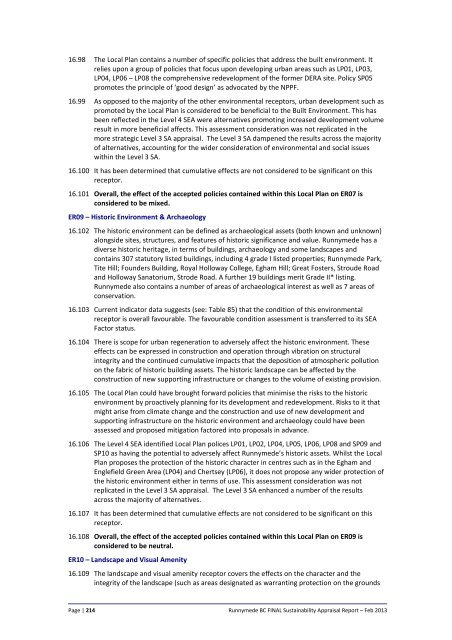DRAFT Sustainability Appraisal Report for the Emerging Local Plan ...
DRAFT Sustainability Appraisal Report for the Emerging Local Plan ...
DRAFT Sustainability Appraisal Report for the Emerging Local Plan ...
You also want an ePaper? Increase the reach of your titles
YUMPU automatically turns print PDFs into web optimized ePapers that Google loves.
16.98 The <strong>Local</strong> <strong>Plan</strong> contains a number of specific policies that address <strong>the</strong> built environment. It<br />
relies upon a group of policies that focus upon developing urban areas such as LP01, LP03,<br />
LP04, LP06 – LP08 <strong>the</strong> comprehensive redevelopment of <strong>the</strong> <strong>for</strong>mer DERA site. Policy SP05<br />
promotes <strong>the</strong> principle of ‘good design’ as advocated by <strong>the</strong> NPPF.<br />
16.99 As opposed to <strong>the</strong> majority of <strong>the</strong> o<strong>the</strong>r environmental receptors, urban development such as<br />
promoted by <strong>the</strong> <strong>Local</strong> <strong>Plan</strong> is considered to be beneficial to <strong>the</strong> Built Environment. This has<br />
been reflected in <strong>the</strong> Level 4 SEA were alternatives promoting increased development volume<br />
result in more beneficial affects. This assessment consideration was not replicated in <strong>the</strong><br />
more strategic Level 3 SA appraisal. The Level 3 SA dampened <strong>the</strong> results across <strong>the</strong> majority<br />
of alternatives, accounting <strong>for</strong> <strong>the</strong> wider consideration of environmental and social issues<br />
within <strong>the</strong> Level 3 SA.<br />
16.100 It has been determined that cumulative effects are not considered to be significant on this<br />
receptor.<br />
16.101 Overall, <strong>the</strong> effect of <strong>the</strong> accepted policies contained within this <strong>Local</strong> <strong>Plan</strong> on ER07 is<br />
considered to be mixed.<br />
ER09 – Historic Environment & Archaeology<br />
16.102 The historic environment can be defined as archaeological assets (both known and unknown)<br />
alongside sites, structures, and features of historic significance and value. Runnymede has a<br />
diverse historic heritage, in terms of buildings, archaeology and some landscapes and<br />
contains 307 statutory listed buildings, including 4 grade I listed properties; Runnymede Park,<br />
Tite Hill; Founders Building, Royal Holloway College, Egham Hill; Great Fosters, Stroude Road<br />
and Holloway Sanatorium, Strode Road. A fur<strong>the</strong>r 19 buildings merit Grade II* listing.<br />
Runnymede also contains a number of areas of archaeological interest as well as 7 areas of<br />
conservation.<br />
16.103 Current indicator data suggests (see: Table 85) that <strong>the</strong> condition of this environmental<br />
receptor is overall favourable. The favourable condition assessment is transferred to its SEA<br />
Factor status.<br />
16.104 There is scope <strong>for</strong> urban regeneration to adversely affect <strong>the</strong> historic environment. These<br />
effects can be expressed in construction and operation through vibration on structural<br />
integrity and <strong>the</strong> continued cumulative impacts that <strong>the</strong> deposition of atmospheric pollution<br />
on <strong>the</strong> fabric of historic building assets. The historic landscape can be affected by <strong>the</strong><br />
construction of new supporting infrastructure or changes to <strong>the</strong> volume of existing provision.<br />
16.105 The <strong>Local</strong> <strong>Plan</strong> could have brought <strong>for</strong>ward policies that minimise <strong>the</strong> risks to <strong>the</strong> historic<br />
environment by proactively planning <strong>for</strong> its development and redevelopment. Risks to it that<br />
might arise from climate change and <strong>the</strong> construction and use of new development and<br />
supporting infrastructure on <strong>the</strong> historic environment and archaeology could have been<br />
assessed and proposed mitigation factored into proposals in advance.<br />
16.106 The Level 4 SEA identified <strong>Local</strong> <strong>Plan</strong> polices LP01, LP02, LP04, LP05, LP06, LP08 and SP09 and<br />
SP10 as having <strong>the</strong> potential to adversely affect Runnymede’s historic assets. Whilst <strong>the</strong> <strong>Local</strong><br />
<strong>Plan</strong> proposes <strong>the</strong> protection of <strong>the</strong> historic character in centres such as in <strong>the</strong> Egham and<br />
Englefield Green Area (LP04) and Chertsey (LP06), it does not propose any wider protection of<br />
<strong>the</strong> historic environment ei<strong>the</strong>r in terms of use. This assessment consideration was not<br />
replicated in <strong>the</strong> Level 3 SA appraisal. The Level 3 SA enhanced a number of <strong>the</strong> results<br />
across <strong>the</strong> majority of alternatives.<br />
16.107 It has been determined that cumulative effects are not considered to be significant on this<br />
receptor.<br />
16.108 Overall, <strong>the</strong> effect of <strong>the</strong> accepted policies contained within this <strong>Local</strong> <strong>Plan</strong> on ER09 is<br />
considered to be neutral.<br />
ER10 – Landscape and Visual Amenity<br />
16.109 The landscape and visual amenity receptor covers <strong>the</strong> effects on <strong>the</strong> character and <strong>the</strong><br />
integrity of <strong>the</strong> landscape (such as areas designated as warranting protection on <strong>the</strong> grounds<br />
Page | 214 Runnymede BC FINAL <strong>Sustainability</strong> <strong>Appraisal</strong> <strong>Report</strong> – Feb 2013

















